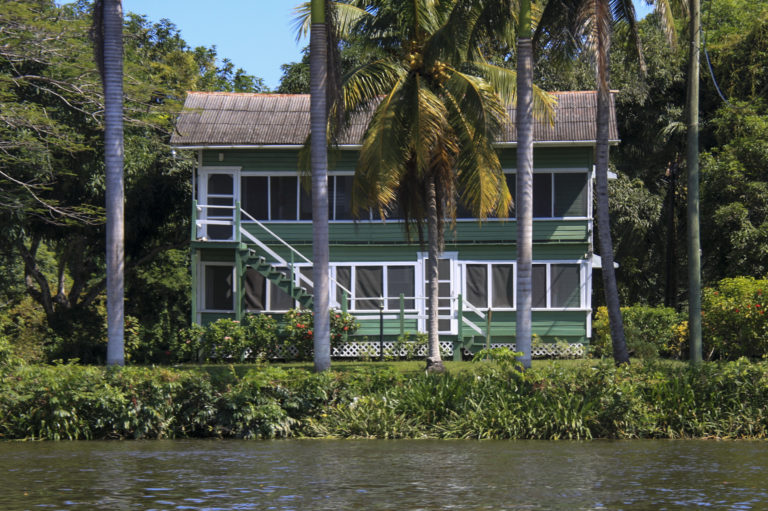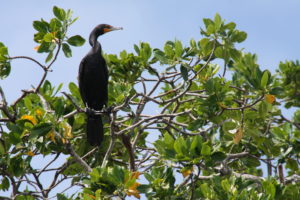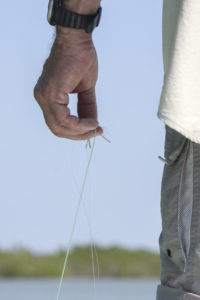 In 2009, I went to Belize River Lodge with my dad, John. This was my second salt water fly fishing experience following a trip to San Felipe, and I was looking forward to gaining more experience fishing for tarpon, permit, bonefish, snook, and more.
In 2009, I went to Belize River Lodge with my dad, John. This was my second salt water fly fishing experience following a trip to San Felipe, and I was looking forward to gaining more experience fishing for tarpon, permit, bonefish, snook, and more.
To get to the Belize River Lodge, we flew into Belize City and drove literally 2 miles from the airport into a dodgy neighborhood where the lodge boat was waiting to pick us up. From the dock, we crossed the river to get to the lodge. Even though the lodge is just outside Belize City, there is no road access.
There’s a lot of wildlife in the area and it was pretty cool to see an alligator lying on a nearby dock as we first arrived. There are birds everywhere as well. I have no idea what these birds are called, but my dad is pretty into them, so I usually shoot pictures of them as we pass.




The old lodge is filled with history and adorned with beautiful native woodwork.
The fishing was good; however, we were not there in perhaps the best season, and there is a fair amount of pressure being so close to Belize City. We didn’t really see any permit and most of the tarpon were smaller in size. We did catch some great barracuda and bonefish though.

 They use panga boats with casting platforms on the bow and poling platforms above the engine for the guide. Each day we fished, we would take the quick 15 minute ride downriver to Belize City Bay, passing million dollar homes along the way. At one of the homes, a massive iguana named “King Tut” perches on the top branch of a tree while looking over his harem.
They use panga boats with casting platforms on the bow and poling platforms above the engine for the guide. Each day we fished, we would take the quick 15 minute ride downriver to Belize City Bay, passing million dollar homes along the way. At one of the homes, a massive iguana named “King Tut” perches on the top branch of a tree while looking over his harem.
 Once we get to the river mouth, we search out the mangrove islands for our fishing grounds. While these mangroves provide habitat, they can prove to be challenging while fishing. One of my first bonefish that I hooked took two left turns around the trees wrapping my line the entire way. John, and our guide Pedro, thought this was funny. So, in no rush to help me free my line, they laughed at me while maneuvering the boat slowly to follow the line around. Once I freed the line, I almost fell out of the boat as I was trying to land the fish. Luckily, John grabbed me by my belt loop and kept me in the boat. This was the most memorial fish of the trip.
Once we get to the river mouth, we search out the mangrove islands for our fishing grounds. While these mangroves provide habitat, they can prove to be challenging while fishing. One of my first bonefish that I hooked took two left turns around the trees wrapping my line the entire way. John, and our guide Pedro, thought this was funny. So, in no rush to help me free my line, they laughed at me while maneuvering the boat slowly to follow the line around. Once I freed the line, I almost fell out of the boat as I was trying to land the fish. Luckily, John grabbed me by my belt loop and kept me in the boat. This was the most memorial fish of the trip.


Further south, there is another river mouth with more flats where we were able to get out of boat and do some wade-fishing. On our way there, we passed these cobia fish farms destined for the Japan fish market. On our way back, we scan the coast looking for downed trees, then fish them for small tarpon and jack.
National Geographic article on cobia fish farms
 Casting is crucial when fishing for snook as they hold way back under the trees. So, after the first day of fishing, the guides set up a practice range for us with a trash can placed underneath a picnic table. The idea was for us to shoot the line into the can without hitting the table. This requires super tight loops.
Casting is crucial when fishing for snook as they hold way back under the trees. So, after the first day of fishing, the guides set up a practice range for us with a trash can placed underneath a picnic table. The idea was for us to shoot the line into the can without hitting the table. This requires super tight loops.
We used 8-9 wt. rods that were great for casting all day and performed well with the bigger fish. John put this set-up to use while catching the best fish of the trip. It was caught on our way home on the last day, at the last dock, and last island that we were planning to fish. As usual, John put down a perfect cast, presenting his chartrouse clouser, and slayed this tarpon. On the way back to the lodge that evening, we enjoyed another fine sunset, making for a great finish to the trip.


